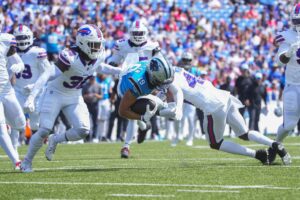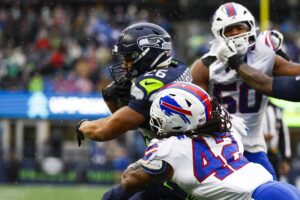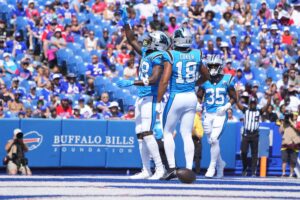The Seattle Seahawks had a tremendous win on Thursday Night Football facing the Los Angeles Rams. The first meeting between the two teams was a defensive slugfest ending in a 9-3 win for the Rams. Somewhat troubling was the lack of performance from the running game, as only 34 yards were produced by running backs. This week we’re going to take a look at some of the negatives and positives of the offensive rushing attack.
Seattle Seahawks-Los Angeles Rams: The Run Game
First and ten, L.A. 22, Second quarter
Formation: Single set back with strong right side
Personnel: One running back with three tight ends and a receiver
The Seahawks were driving towards the end zone looking to take a 7-0 lead over the Rams. Seattle was having issues running the ball against a strong Rams defensive line. Coming out with tight ends Jimmy Graham, Nick Vannett and Luke Willson (blue) lined up on the ends of the line, Seattle was determined to run the ball.
The blocking scheme employed by the Seahawks did its best to neutralize the two strong defensive tackles lined up across from them. Aaron Donald and Dominique Easley were wreaking havoc on the Seattle offensive line up to this point. By double teaming both Donald and Easley, Seattle hoped to get a good push on the interior of the offensive line. The entire line, excluding tight end Luke Willson, blocks down towards the left. Willson, on the other hand, blocks his man to the right. The importance of this, if done correctly, is to open up the “D” gap for running back Thomas Rawls to run through.
Los Angeles shows blitz with six men on the line of scrimmage, four with their hands in the dirt and two standing up. Tyler Lockett is lined up to the right of the formation with Trumaine Johnson across from him and two safeties ten yards off the ball. The Rams were looking to stop the run.

The play is blocked well considering the issues Seattle has been having on the line. Nick Vannett (purple) blocks his man down the line with Willson holding down the right side allowing Rawls to hit the “D” gap. The double teams effectively contain Donald and Easley. Rookie tackle George Fant was the only player to initially fail at his block, getting thrown aside by Eugene Sims. Guard Mark Glowinski slides off a double team, well under control by center Justin Britt, and picks up Sims to keep him from blowing up the play.

Good Decisions
Two holes appear to come open for Rawls. The “D” gap, which is the intended target, and the “B” gap between the center and the guard. One of the issues faced by Seattle running backs early in the year was the inability to hit the assigned hole properly and fight through contact. Rawls demonstrates both of those qualities here. He bypasses the “B” gap, even if it was the more opportunistic option, as he could have cut it back to avoid linebacker Alec Ogletree (yellow). However, that almost certainly would have resulted in a loss of yardage. The reason the “B” gap would have been a loss is the blocking scheme is having the linemen block down and to the left. This means that the hole would have been closed by the time Rawls made his cut and tried to hit it. The inability to stick to the play is the issue Christine Michael faced during his time in Seattle.
Rawls hits the “D” gap hard and Ogletree is crashing down to meet him as well. Vannett has to let William Hayes off the block to avoid a holding call and Rawls falls forward for a gain of three. While a gain of three doesn’t sound like much, in a game full of negative plays in the Seattle rushing attack, a gain of three sounds pretty good. Even without a large gain, seeing a play blocked well up front is a positive for the offensive line that has been shuffled around and has struggled in run blocking.

First and ten, Seattle 18, Third quarter
Formation: Single set back with strong right side
Personnel: One running back, one tight end, three wide receivers
Seattle again comes out in a single set back here. However, this time they bunch Doug Baldwin and Jermaine Kearse, have Graham offset of the line, and Lockett split out to the left. The Rams come out in a nickel package with four defensive linemen and two linebackers. The formation and personnel the Seahawks show doesn’t tip their hand to pass or run this time, so the Rams have to account for both.
Seattle’s plan for the blocking scheme is a little puzzling on this play. They expect Kearse to block Hayes one on one. Graham could have chipped Hayes, but this was a setup for failure. Glowinski is tasked with blocking Donald alone, which also fails terribly as he gets blown by and ends up on his face. Germain Ifedi does a nice job chip blocking Michael Brockers, to assist Bradley Sowell, before moving on to block Ogletree.

Recurring Issues
Within seconds the play is blown up. Glowinski barely touches Aaron Donald and while Graham should have stayed longer and chipped William Hayes, he instead tries to block downfield. The end result is moments after he takes the snap Rawls is ready to be apart of a Rams sandwich.
Rawls is attempting to hit the “B” gap between the center and guard. Besides Kearse and Glowinski, this play is well blocked and should have gone for at least ten yards. However, Rawls is hit at the line of scrimmage and dropped for no gain. This is typical of the Seattle run game in 2016. A lack of communication coupled with a young offensive line has led to little to no opportunity on many occasions for the running back.

This play is symptomatic of the issues plaguing the Seahawks during the 2016 campaign. On their way into the playoffs and possibly the second seed in the NFC, Seattle needs to shore up their issues in communication and work to put their players in the best position to succeed. Next week they face the fifth-ranked defense per Football Outsiders in the Arizona Cardinals, who will be another test for this struggling run game.
Second and six, Seattle 35, Third quarter
Formation: Single set back with an even formation
Personnel: One running back, two tight ends and two receivers
Seattle used the single set back formation many times to help its rushing attack. This time it’s with Willson and Graham each lined up offset on the ends of the line, with Kearse and Baldwin outside of them. Los Angeles is in a dime package showing a 4-3 front with the defensive front offset to the left. This means they’re either expecting a run that way or believe they can more effectively pressure the quarterback by attacking the left side of the line.
The idea behind the blocking scheme is to wash the defensive line right with only Luke Willson coming back to close off the back side of the run. No single defensive player is set to be double teamed on this play. Willson sealing off the back of the play allows him to hit the first man he sees leaking through that could make a play on the runner. Thomas Rawls is slated for another inside run to the right where he’s attacking the “B” gap, headed straight for the heart of the Rams defense.

Solid Execution
The much-maligned offensive line executes the blocking assignments well. Willson does his job and keeps Donald from blowing up the play after he gets by Fant. Germain Ifedi forces Ethan Westbrooks to the ground and out of the play. Only Kearse fails to execute his block, allowing a player to come around. Fortunately by the time he arrives Rawls is through the hole and into the secondary.
Thomas Rawls hits the hole and presses to the right side towards linebacker Mark Barron (blue). This freezes Barron and allows Rawls to use his vision and cut back to the left, utilizing his blockers to gain additional yards. At the same time, Baldwin is getting into position to make a block on Trumaine Johnson, which could be crucial if Rawls could get back to the right side.

Rawls has now run for what is “blocked for him,” which means he has run for exactly what the line allowed him to get on the initial push without any extra effort. The offensive unit, however, continues to set up blocks and Rawls continues to use his vision and make people miss while utilizing his blocks. Continuing to pursue the lane to his left, he gets tripped up over Ogletree, who goes to the ground attempting to tackle him. It appears he could regain his balance, but before he does he is gang tackled by three Rams players.

Positives
This was the best run of the night for Thomas Rawls, as he gained three times the yardage that was blocked for him. Not only did he use his blocks well, but he fought through contact to push his tackles for an extra six yards. In stark contrast to the previous play, this is the rushing attack Seattle needs to make a deep playoff run and take pressure off of Russell Wilson.

First and goal, L.A. nine, Third quarter
Formation: Single set back with an even formation
Personnel: One running back, two tight ends, and two receivers
For the fourth time, the Seahawks show a single set back. Using the same personnel and same formation as the last play, it was clear that they wanted a rushing touchdown. Los Angeles used its nickel package again, lining up in a 4-3 front with the linemen centered on the Seattle offensive line.
On this play, Seattle utilizes misdirection to assist their running back. The offensive line blocks down to the right while Willson cuts across the formation to the left. Graham will chip his defender and then break left as well to block for Rawls. The purpose is to deceive the defense into thinking that the play is a stretch to the right when in fact it’s a cutback to the left.

Rawls takes the handoff and cuts back to the left, with his tight ends providing him with good blocks. Los Angeles, however, is not fooled for long, with many defenders peeling off their blocks to pursue the runner. The biggest threat to Rawls is strong safety Maurice Alexander, who is the last player before the end zone.

Vision Adjustment
As demonstrated in the previous play, Thomas Rawls has the vision to be a solid NFL running back. However, this play did not demonstrate that. The second-year running back cuts inside the block of Luke Willson right at Alexander (blue) before the goal line when Graham (yellow) was in good position to attempt a block on the safety if Rawls stretches the play to the outside. He had Willson sustaining a block and would have had only Alexander to beat, even if Graham couldn’t make the block.
If Rawls stretches it to the outside, he outruns the Rams pursuing him as well as isolating the safety for a much easier time to the end zone. That’s not how the play went though. Rawls cuts inside of Luke Willson, is slowed by Alexander, and is tackled while almost fumbling.

Regardless of which lane Rawls should have taken, the run was a gain of seven on first and goal. This led to a Doug Baldwin touchdown on a beautiful route that left cornerback Troy Hill wondering where his shoes were. The issue of his vision on this play is hardly concerning due to ample evidence of his fantastic vision in most of his opportunities. Rawls is only a second-year player with more than enough time to improve his craft.
Looking Forward
The Seahawks stay home for a divisional matchup against the Cardinals with a perfect 7-0 home record so far. Even with Seattle locking up the NFC West against the Rams, they will need to win out to guarantee the number two seed in the NFC. With a first-round bye, Seattle would hope to get rookie running back C.J. Prosise back as a change of pace back and allow the team some well-deserved rest.
Main Photo:






